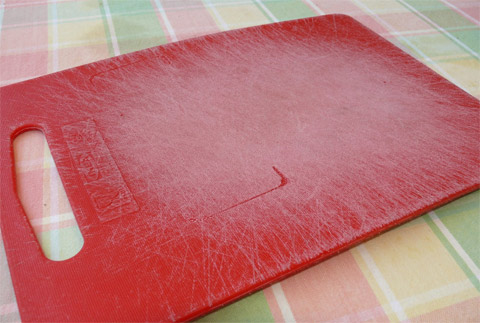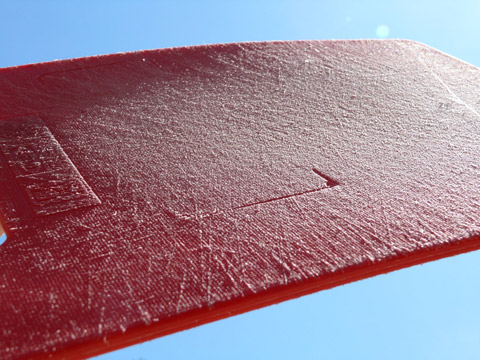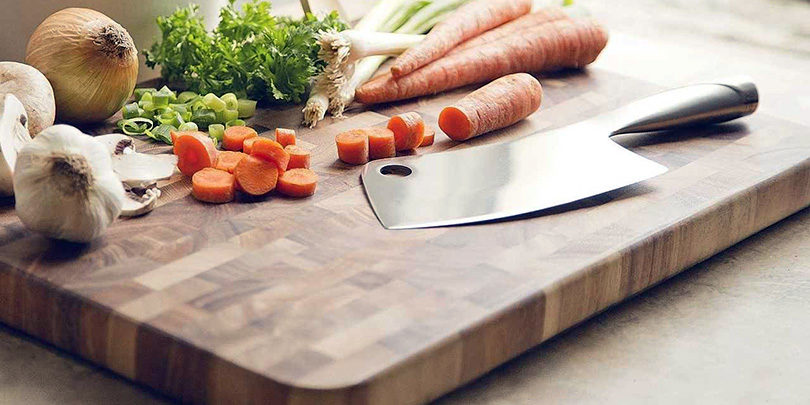Updated article : 31/07/2019
We encourage you to eat healthy foods and cooking yourself more often possible. You have probably already wondered what was the best cutting board.
Should we choose a wooden plank or a plastic ? Would wooden plank be, as so-called, less hygienic ? A Board used plastic doesn't risk free small pieces of plastic in food ? What are the tips to have a Board of impeccably clean ? Food dangers led the investigation to illuminate your lanterns for the purchase of your next cutting board !
Let's start with a small summary on different cutting boards market.
Wooden planks
Beech Board : It is the most common Board. The wood is relatively hard but may warp in contact with water.
Exotic wooden plank : Very resistant, rot-proof but not very environmentally friendly because it participates in the deforestation of tropical forests (Asia, Africa, South America).
Bamboo Board : It does not penetrate water (so does gondola) and is highly resistant. Indeed, It is harder than beech or maple. It is also rather ecological since bamboo is a renewable resource (It is not necessary to replant because bamboo repels all alone and very quickly). Attention however to the finish, If the Board is not perfectly smooth plan on sanding with Emery to avoid small splinters.
The downside of wooden planks, in general, It is that they eventually deform to some and to split due to moisture if they are not solid wood.
Plastic boards

PVC Board (Polyvinyl chloride) : Non-porous, very solid, would ensure a total hygiene (lowest disadvantages).
HDPE Board (polyethylene high density) : Non-porous, would ensure a total hygiene, It is very rigid and resistant.
The tempered glass Board
It is resistant to high temperatures, washes very well, can go in the dishwasher and is not afraid of scratches from knives. Attention to a Board with non-slip pads. The sensation of cutting is different, You must love… The glass is very hard for knives, think about sharpening often.
The marble Board
Uncommon, the marble is very heavy to carry but, like glass, it washes very well and is not afraid of scratches from knives. Like glass, the marble quickly damage knives.
What is the most hygienic Board ?
The microbiologist from the University of California, Dean Cliver, has conducted an experiment [3], [4], to know that she was the Board the more hygienic between wooden plank, plastic and marble. He filed at the center of the boards bacteria, It was then soaked, washed with conventional detergent then dried. Samples have been made at the centre boards and edges.
microbiologist from the University of California, Dean Cliver, has conducted an experiment [3], [4], to know that she was the Board the more hygienic between wooden plank, plastic and marble. He filed at the center of the boards bacteria, It was then soaked, washed with conventional detergent then dried. Samples have been made at the centre boards and edges.
- It found that the marble Board showed some signs of bacteria but that were present on the surface of the plank ! Indeed, as the Board is smooth, the bacteria have spread everywhere contaminating the entire surface (even if the layer of bacteria remains low).
- Wooden plank presents in places of the small colonies of bacteria. The wood being porous, In contrast to the marble, bacteria have remained where they were applied. They do not spread and thus contaminate not any Board.
Most surprising, wood is naturally the germs would rid. Cliver explains that the wood "is a very porous material by this fact., the liquid is sucked into the wood by capillarity. When there's bacteria in the liquid, they come in wood and come back ever in life., and adds that «»[bacteria] die slowly. It may take a few hours and finally they are no longer able to cause any problems".
After 12 h, It was indeed left traces of bacteria but had reduced their number of 98 % more from 99,9% in some cases [5].
- The Board plastic presents more bacteria that the other two boards. Bacteria lodge in the small cavities and scratches and are thus not eliminated by washing. Worse, they reproduce faster and more easily in these cavities, explains the microbiologist.
Conclusion : The best Board is wood. The Board marble arrives even before the Board plastic, who is in the last position. These results do not surprise the teacher because he, in many similar experiences, wood always ends up winner.
Other problems of plastic
Unlike the boards HDPE, PVC are toxic !
Indeed, as we have seen in section Is bottled water dangerous ?, PVC is considered hazardous to health and the environment. It contains the lead, cadmium, of phthalates and DEHA.
Bis adipate(2-ethylhexyl), also known as DEHA, is a chemical that can cause cancer (study on laboratory animals), to have negative impacts on the liver, the kidneys, the spleen and bone formation [1] [2].
Phthalates contaminate food when the plastic is in contact with food. Can say that the contact time is very low for a food that is on a Board (compared to water bottles, cans, etc.), that phthalates migrate to food. This is surely true, But what is for small plastic pieces that break off plastic boards worn by knives, end up directly in our stomachs (even in very small quantities) ? Although often, scratching a little with her fingernail, It can very easily pick up a bit of plastic Board.

Cutting particularly worn plastic Board
Recommendations
It is recommended by experts to use two cutting boards, one for meat and one for fruits and vegetables, in order to avoid contamination between several raw food.
Replace the boards too much waste.
Tip : It is possible to plane wooden plank to make new smooth. So do something for the environment and economy for your portfolio.
You'll understand, We recommend wooden cutting boards, but as says the microbiologist Cliver, It is necessary that the Board is in a very hard wood to prevent germs grow in deep scratches caused by knives.
There are boards that are equipped with an antibacterial coating. It is first and foremost a marketing argument because according to studies, efficacy against germs is relative and the coating would start quickly.
Tips for washing your boards :
Clean the Board after each use.
- Wash your boards with the detergent and rub well.
- Rinse with warm water.
- Disinfect with slightly enriched with water of bleach (5ml to 500ml of water). Attention however to rinse very thoroughly the plank because bleach is not a food product (This step does not unanimously).
- To finish, allow to dry in the open air, or dry with a clean, dry cloth.
It is also possible to wash his surfboard in boiling water but this is not always possible for large boards.
Attention : do not pass your wooden board in the dishwasher !
Here is a selection of wooden cutting boards that we can recommend :
Main sources :
[1]. The Government of Canada chemical substances Web site (www.chemicalsubstanceschimiques.GC.ca)
[2]. Technical Fact Sheet on Di (2-ethylhexyl) adipate.
[3]. amgar.blog.processalimentaire.com
[4]. barfblog.FoodSafety.KSU.edu
[5]. www.IngentaConnect.com


The timber is greater than the plastic material of cutting board. The plastic leaves small “shavings” which can become embedded in your dishes and to a lesser extent, in your digestive system. No need to tell you that it does not digest! The chopping wood in turn, traps bacteria between the fibers and allowed to suffocate to death. I have one for almost a decade, and I never had a problem.
This is exactly what we can read in the article
For bamboo planks, must adhesives, necessarily chemicals…
I agree with previous comments about the superiority of wood plastic; I would even add that the olive wood is probably one of the hardest and most durable woods. So ideal pouyr cut without blunt knives.
In addition to follow the way of customization, this site can even make burn his board cut, and delivery is free
https://www.loliv.com > Home> Olive Wood> Cutting board olive wood
Hello,
Bleach ??? Vinegar, rather (obviously) !
Hello,
What to think about stainless steel boards?
elavil and heartburn
elavil and heartburn